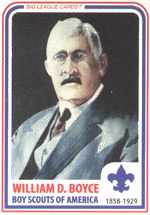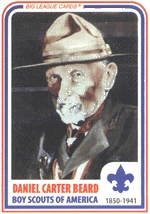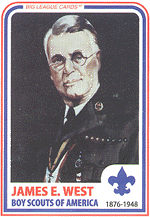Scouting History and Traditions
One day in 1909 in London, England, an American visitor, William D. Boyce, lost his way in a dense fog. He stopped under a street lamp and tried to figure out where he was. A boy approached him and asked if he could be of help.
"You certainly can," said Boyce. he told the boy that he wanted to find a certain business office in the center of the city.
"I'll take you there," said the boy.
When they got to the destination, Mr. Boyce reached into his pocket for a tip. But the boy stopped him.
"No thank you, sir. I am a Scout. I won't take anything for helping."
"A Scout? And what might that be?" asked Boyce.
The boy told the American about himself and his brother Scouts. Boyce became very interested. After finishing his errand, he had the boy take him to the British Scouting office.
At the office, Boyce met Lord Robert Baden-Powell, the famous British general who had founded the Scouting movement in Great Britain. Boyce was so impressed with what he learned that he decided to bring Scouting home with him.
On February 8, 1910, Boyce and a group of outstanding leaders founded the Boy Scouts of America. From that day forth, Scouts have celebrated February 8 as the birthday of Scouting in the United States.
What happened to the boy who helped Mr. Boyce find his way in the fog? No one knows. He had neither asked for money nor given his name, but he will never be forgotten. His Good Turn helped bring the Scouting movement to the United States of America.
The history that has been formed and the traditions that have been handed down help make Scouting an interesting and exciting program for our boys. I hope that after reading a few of these pages, you will have another tale to tell around a campfire, at a roundtable, during a Pow Wow, or at a crackerbarrel. In this way you will be adding to and perpetuating the grand history of the Boy Scouts.
Founders of Boy Scouts of America
William D. Boyce
 In 1909, Chicago publisher William D. Boyce lost his way in a dense London fog. A boy came to his aid and, after guiding the man, refused a tip, explaining that as a Scout he would not take a tip for doing a Good Turn. This gesture by an unknown Scout inspired a meeting with Robert Baden-Powell, the British founder of the Boy Scouts. As a result, William Boyce incorporated the Boy Scouts of America on February 8, 1910. He also created the Lone Scouts, which merged with the Boy Scouts of America in 1924.
In 1909, Chicago publisher William D. Boyce lost his way in a dense London fog. A boy came to his aid and, after guiding the man, refused a tip, explaining that as a Scout he would not take a tip for doing a Good Turn. This gesture by an unknown Scout inspired a meeting with Robert Baden-Powell, the British founder of the Boy Scouts. As a result, William Boyce incorporated the Boy Scouts of America on February 8, 1910. He also created the Lone Scouts, which merged with the Boy Scouts of America in 1924.
Lord Robert Baden-Powell
1857-1941
As a youth, Robert Baden-Powell greatly enjoyed the outdoors, learning about nature and how to live in the wilderness. After returning as a military hero from service in Africa, Baden-Powell discovered that English boys were reading the manual on stalking and survival in the wilderness he had written for his military regiment. Gathering ideas from Ernest Thompson Seton, Daniel Carter Beard, and
others, he rewrote the manual as a nonmilitary nature skill book and called it Scouting for Boys. To test his ideas, Baden-Powell brought together 22 boys to camp at Brownsea Island, off the coast of England. This historic campout was a success and resulted in the advent of Scouting. Thus, the imagination and inspiration of Baden-Powell, later proclaimed Chief Scout of the World, brought Scouting to
youth the world over.
More On Baden-Powell
Baden-Powell's Last Message
Ernest Thompson Seton
1860-1946
 Ernest Thompson Seton was born in South Shields, Durham, England but emigrated to Canada with his family at the age of 6. His original name was Ernest Seton Thompson.
Ernest Thompson Seton was born in South Shields, Durham, England but emigrated to Canada with his family at the age of 6. His original name was Ernest Seton Thompson.
His sketches as a youth won awards. Consequently, he was sent to study art in London at The Royal Academy School of Painting and Sculpture. Later, he went to Paris for further study. In 1881, he became the Naturalist for the government of Manitoba.
The Ladies Home Journal magazine asked him to write a series on woodcraft for boys. The first article appeared in May, 1902. On the first day of July in 1902, he founded the Woodcraft Indians. He wrote a book, The Birchbark Rolls of the Woodcraft Indians as a guide for the program. This book was sent to Baden-Powell in July of 1906 as a precursor to Seton's visit to England for a series of fall lectures. On October 30th, the two men met at the Savoy Hotel..
He was Chief Scout from 1910 to 1915. The original 1910 handook included 50 pages from Baden-Powell and 100 pages of Seton's writings.
Seton developed a plan for incorporating younger boys into Scouting in 1911. Called "The Cubs of America", it used the bear cub as its symbol. Disagreements among Scouting's founders over the value of the new program caused it to be set aside.
Seton had a falling out with James West and left the movement in 1915. He disagreed with the military style set by Baden-Powell and West. Seton then founded the Woodcraft League of America. He later came back to help organize Cubbing for the younger boys.
Seton received the seventh Silver Buffalo award in 1926; the first year it was offered
Daniel Carter Beard
1850-1941
 To the Scouts that knew him, he was "Uncle Dan". Like Seton and Baden-Powell, he was an accomplished illustrator. He stood out from the crowd due to his snow-white moustache and goatee. He was born in Cincinnati, Ohio in 1850 but grew up in Covington, Kentucky where he learned the many tales of Daniel Boone and the American pioneers.
To the Scouts that knew him, he was "Uncle Dan". Like Seton and Baden-Powell, he was an accomplished illustrator. He stood out from the crowd due to his snow-white moustache and goatee. He was born in Cincinnati, Ohio in 1850 but grew up in Covington, Kentucky where he learned the many tales of Daniel Boone and the American pioneers.
He graduated from Wallace's Academy, as a civil engineer and surveyor. He made insurance maps until he visited New York on vacation and stayed to study art. His illustrations and articles graced the pages of St. Nicholas Magazine (where Jungle Book first appeared) and Youth's Companion. These articles and accompanying illustrations were later compiled into books. He taught art from 1883 to 1890 at the Women's School of Applied Design. Uncle Dan was chosen to illustrate Mark Twain's A Connecticut Yankee In King Arthur's Court.
To keep alive the spirit of the pioneers, he formed "The Society of the Sons of Daniel Boone". This group grew to become the largest boy's club in America. It developed into "The Boy Pioneers" in 1905. His writings on the group appeared in Recreation magazine for which he was an Editor.
The boys were encouraged to keep an old unloaded gun as part of their fort. A fort was a brandh of the club. The forts would keep records of their good deeds n protecting forests and wildlife by cutting notches in their gun stocks. The boys chanted:
Cut a notch, cut a notch, cut a notch soon,
For we are the Sons of Daniel Boone
He was quick to embrace the Boy Scout movement and was its first National Commissioner and Chairman of the Court of Honor. It was his idea to Americanize the Boy Scout fleur-de-lis by adding the American eagle and shield. His design for the emblem was granted a design patent by the U.S. patent office on July 4, 1911.
Like James West, Beard was originally against a younger boy program for Scouting and felt the term "Cub" derogatory.
He received the only gold Eagle badge ever awarded and the Roosevelt gold medal for distinguished service. He was the president of the Society of Illustrators and of the Camp Fire Club. Near Mt. McKinley in Alaska is Mt. Beard that was named in his honor.
James E. West
unkown-1948
 James E. West was appointed the first Chief Scout Executive of the Boy Scouts of America in 1911. Although orphaned and physically handicapped, he had the perseverance to graduate from law school and become a successful attorney. This same determination provided the impetus to help build Scouting into the largest and most effective youth organization in the world. When he retired in 1943, Dr. West
was recognized throughout the country as the true architect of the Boy Scouts of America.
James E. West was appointed the first Chief Scout Executive of the Boy Scouts of America in 1911. Although orphaned and physically handicapped, he had the perseverance to graduate from law school and become a successful attorney. This same determination provided the impetus to help build Scouting into the largest and most effective youth organization in the world. When he retired in 1943, Dr. West
was recognized throughout the country as the true architect of the Boy Scouts of America.
William Hillcourt
1900-1992
American Boy Scouting has been influenced by many men; Seton, Beard, West, Hurt, and others stand out. But one man more than any other personified the life of American Boy Scouting; William Hillcourt, better known as Green Bar Bill.
Bill was a native of Denmark where he became a Boy Scout in January, 1911 at 11 years of age after he had been given the newly translated Scouting For Boys as a Christmas Gift. He became the Danish equivalent of an Eagle Scout and was sent by his Troop to the First World Jamboree in London in 1920. The success of the Danish team earned it the right to host the 2nd World Jamboree.
Bill wrote his first book at the age of 23. It was a tale of Scout camping based on his own Patrol's experiences.
New York attracted Bill in September of 1926. His first Boy Scout job was with the BSA Supply Service. Bill later convinced James West that the BSA was not using the Patrol method correctly. West challenged him to write the Handbook For Patrol Leaders.
Bill took the nickname "Green Bar Bill" from the patrol leaders badge as his Boy's Life pseudonym where he became an Assistant Editor. Green Bar Bill wrote over 300 articles for Boy's Life.
In 1934, he and his wife, Grace, moved onto the Schiff Scout Reservation. It was here that he wrote a new book for Scoutmasters. He formed Troop 1 of Mendham, New Jersey to learn firsthand, the trials and joys of a Scoutmaster.
Bill was a member of the first Wood Badge course in America at Schiff in May, 1936. He was Troop Leader and Dog's Body ( Senior Patrol Leader) for the second. He recieved his beads in 1939. This gave him the qualifications to become Deputy Camp Chief of the United States and the Scoutmaster of Wood Badge #1 in 1948.
Bill retired in 1965 after writing the popular 1959, 6th edition, of the Boy Scout Handbook. He also held the title of National Director Program Resources and was the BSA's only Director of Scoutcraft
In all, he attended 13 World Jamborees and all of the National Jamborees.
To get Scouting back on track following the introduction of "improved Scouting" in 1972, Bill was invited to come out of retirement and write the 1979, edition of the Boy Scout Handbook.
If there ever was a Scouter's Scouter, it was Bill. He breathed romance and excitement into the program. He gave Scouting it's outdoor flavor. May we never lose this taste.

History and Traditions
 In 1909, Chicago publisher William D. Boyce lost his way in a dense London fog. A boy came to his aid and, after guiding the man, refused a tip, explaining that as a Scout he would not take a tip for doing a Good Turn. This gesture by an unknown Scout inspired a meeting with Robert Baden-Powell, the British founder of the Boy Scouts. As a result, William Boyce incorporated the Boy Scouts of America on February 8, 1910. He also created the Lone Scouts, which merged with the Boy Scouts of America in 1924.
In 1909, Chicago publisher William D. Boyce lost his way in a dense London fog. A boy came to his aid and, after guiding the man, refused a tip, explaining that as a Scout he would not take a tip for doing a Good Turn. This gesture by an unknown Scout inspired a meeting with Robert Baden-Powell, the British founder of the Boy Scouts. As a result, William Boyce incorporated the Boy Scouts of America on February 8, 1910. He also created the Lone Scouts, which merged with the Boy Scouts of America in 1924.
 Ernest Thompson Seton was born in South Shields, Durham, England but emigrated to Canada with his family at the age of 6. His original name was Ernest Seton Thompson.
Ernest Thompson Seton was born in South Shields, Durham, England but emigrated to Canada with his family at the age of 6. His original name was Ernest Seton Thompson.
 To the Scouts that knew him, he was "Uncle Dan". Like Seton and Baden-Powell, he was an accomplished illustrator. He stood out from the crowd due to his snow-white moustache and goatee. He was born in Cincinnati, Ohio in 1850 but grew up in Covington, Kentucky where he learned the many tales of Daniel Boone and the American pioneers.
To the Scouts that knew him, he was "Uncle Dan". Like Seton and Baden-Powell, he was an accomplished illustrator. He stood out from the crowd due to his snow-white moustache and goatee. He was born in Cincinnati, Ohio in 1850 but grew up in Covington, Kentucky where he learned the many tales of Daniel Boone and the American pioneers.
 James E. West was appointed the first Chief Scout Executive of the Boy Scouts of America in 1911. Although orphaned and physically handicapped, he had the perseverance to graduate from law school and become a successful attorney. This same determination provided the impetus to help build Scouting into the largest and most effective youth organization in the world. When he retired in 1943, Dr. West
was recognized throughout the country as the true architect of the Boy Scouts of America.
James E. West was appointed the first Chief Scout Executive of the Boy Scouts of America in 1911. Although orphaned and physically handicapped, he had the perseverance to graduate from law school and become a successful attorney. This same determination provided the impetus to help build Scouting into the largest and most effective youth organization in the world. When he retired in 1943, Dr. West
was recognized throughout the country as the true architect of the Boy Scouts of America.
